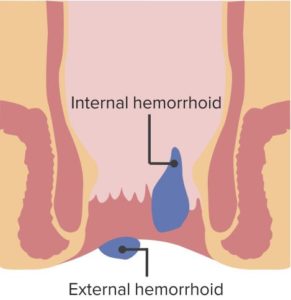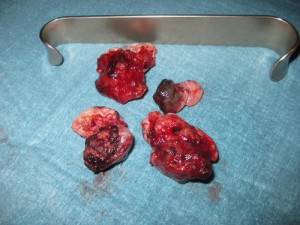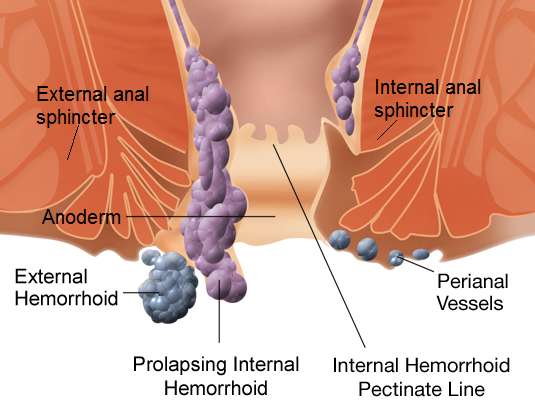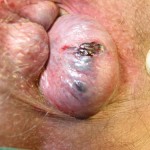Hemorrhoids (Piles) — Symptoms and Treatment
Table of Contents
- Definition of Hemorrhoids
- Epidemiology of Hemorrhoids
- Etiology of Hemorrhoids
- Pathology and Pathophysiology of Hemorrhoids
- Symptoms of Hemorrhoids
- Diagnosis of Hemorrhoids
- Differential Diagnoses of Hemorrhoids
- Therapy of Hemorrhoids
- Progression and Prognosis of Hemorrhoids
- Review Questions
- References
Image: “Types of hemorrhoids” by WikipedianProlific and Mikael Häggström. License: CC BY-SA 3.0
Definition of Hemorrhoids
Hemorrhoids are venous cushions found in the lower rectum and help with stool control. Patients present with symptoms when the vascular tissue becomes inflamed and swollen. There are three classes of hemorrhoids, based on their origin. Their origin also determines blood supply, histology, and possibility to cause pain.
Epidemiology of Hemorrhoids
Spread of hemorrhoids
About 5 % of the general population suffer from hemorrhoids. While there are no differences between the sexes, middle-aged adults are most likely to develop the condition.
Etiology of Hemorrhoids
Causes of hemorrhoids
Healthy hemorrhoid cushions are normal structures in the rectum. Their transformation into an inflamed and swollen nuisance is the source of a great deal of speculation. The main theory revolves around poor venous return during:
- Constipation
- Sitting for extended periods of time
- Pregnancy
When patients strain during defecation (due to a low fiber diet) venous return is reduced. This may contribute to rectal vasculature engorgement. Also during pregnancy, the uterus may compress the inferior vena cava resulting in venous congestion which may result in hemorrhoids.
Other conditions that may cause hemorrhoids include:
- Anal intercourse
- Diarrhea
- Obesity
- Rectal surgery, including episiotomy
Risk factors are:
- Chronic constipation
- Portal hypertension
- Pregnancy
Pathology and Pathophysiology of Hemorrhoids

“Hemorrhoids” Image created by Lecturio
The term hemorrhoids describes the symptoms associated with swollen and inflamed hemorrhoid tissue. Normally, non-inflamed hemorrhoid tissue rarely causes symptoms. Once the arteriovenous plexus of the hemorrhoid tissue becomes dilated the suspensory muscles are stretched and the rectal mucosa becomes engorged and is damaged easily. This leads to bleeding which will produce bright red blood.
The weakening of the suspensory muscles of the rectum results in prolapse and fecal incontinence. Internal hemorrhoids, with an origin above the dentate line, are not innervated by cutaneous nerves are usually painless. They can prolapse and thrombose causing the anal sphincter to spasm, resulting in discomfort. External hemorrhoids are innervated by cutaneous nerves and can be quite painful. These types of hemorrhoids can also form a thrombus.
Symptoms of Hemorrhoids
Signs of hemorrhoids
Hemorrhoids present with a variety of symptoms that are nonspecific and relate to a variety of diseases. The most common symptoms of hemorrhoids include:
- Rectal pain
- Bleeding
- Pruritus
- Anal prolapse
Rectal bleeding of any type should be thoroughly investigated. Colon malignancy should always be ruled out by direct inspection via anoscopy, sigmoidoscopy, or colonoscopy.
Diagnosis of Hemorrhoids
A patient with asymptomatic hemorrhoids should not be treated. A thorough history is very important to characterize the signs and symptoms associated with hemorrhoids. Internal hemorrhoids are graded based on their prolapse into the anal canal. A Grade I internal hemorrhoid projects into the anal canal but does not prolapse where a Grade IV hemorrhoid is constantly prolapse and cannot be reduced. There is an increased risk for these hemorrhoids to strangulate or thrombose.
Lab testing
A complete blood count is useful to establish an infection or anemia from excess bleeding. Coagulation studies are also beneficial.
Visual inspection
Anoscopy is useful when evaluating internal hemorrhoids while sigmoidoscopy can evaluate tissue in the sigmoid. This is useful to rule out malignancy and inflammatory diseases such as ulcerative colitis.
Differential Diagnoses of Hemorrhoids
Clinical pictures similar to hemorrhoids
- Inflammatory bowel disease (Ulcerative Colitis and Crohn’s disease)
- Condyloma
- Coagulopathy
- Anal fissure
- Anal fistula
Therapy of Hemorrhoids
Treatment of hemorrhoids
Treatment for both internal and external hemorrhoids is taken in a stepwise manner with the most conservative, noninvasive methods attempted first before surgery is attempted. Acute symptoms, pain, and itching, are treated with topical astringents, witch hazel or phenylephrine (found in some hemorrhoid creams), and NSAIDS. A sitz bath in warm water may also relieve these symptoms. For severe cases, corticosteroid suppositories are effective.

To shrink hemorrhoid and prevent it from becoming inflamed in the future the American College of Gastroenterology recommends an increase indietary fiber and fluids. Exercise and weight loss may also be effective.
If this is insufficient there are a variety of outpatient procedures available to patients. Banding and sclerotherapy can be performed in the clinic with minimal risk to the patient and relatively good outcomes.
Surgical treatment is usually reserved for patients with severe hemorrhoids or complicated cases that require advanced monitoring. Hemorrhoids treated surgically are less likely to recur, compared to those treated conservatively.
Progression and Prognosis of Hemorrhoids
Hemorrhoids usually resolve spontaneously or with conservative treatment that includes changes to diet and exercise. If left unattended hemorrhoids can progress to develop thrombosis, infections, fistulas, anal fissures, incontinences, and abscesses. The recurrence rate for healed hemorrhoids is relatively common at 10–20 %.
Review Questions
The correct answers can be found below the references.
1. The first test to perform on a patient presenting with new onset bright red blood with painless bowel movement is?
- Colonoscopy
- Anoscopy
- Digital Rectal Exam
- Fecal Occult Blood Test
2. Which condition increases the risk of developing hemorrhoids?
- Hypertension
- Pregnancy
- Diverticulosis
- Inflammatory Bowel Syndrome
3. Once a patient has been diagnosed with symptomatic hemorrhoids, what is the first line of treatment?
- Banding
- Dietary changes with fiber supplementation
- Reassurance


The Symptoms of Piles do vary between individuals. It is influenced by the cause and the nature of the condition. Some common symptoms of piles include bright red blood after a bowel movement, discharge of mucus while passing stool, the affected area around the anus becomes itchy and inflamed. Feeling of a hard lump at the anus region and the patient feels having full bowel, even after going to the toilet.
ResponderEliminarSymptoms of piles
Thank you for share your knowledge with us, hope you have a great week :)
EliminarHemorrhoids can be very much frustrating. Here Hemorrhoids Symptoms & Reasons Dr. Atul Patil piles specialists will provide the best pile treatment in pune at a very affordable price!
ResponderEliminarThanks for sharing very useful post. Piles can be very painful and uncomfortable.Try out piles remedy
ResponderEliminarGreat blog post! This information is needed to be spread for people to gain understanding of a disease that is quite common. Understand more piles remedy!
ResponderEliminarThis blog is really helpful to fight against piles and gives wonderful solution to become free from this disease.
ResponderEliminarHemaway seat
Good thing that you are teaching about hemorrhoids. I remember when I had them and they were really painful. Glad that I discovered sitz bath uk
ResponderEliminarPiles Treatment Thanks for sharing valuable information with us. Keep posting!!
ResponderEliminarPiles Laser Treatment
brillant piece of information, I had come to know about your web-page from my friend hardkik, chennai,i have read atleast 9 posts of yours by now, and let me tell you, your webpage gives the best and the most interesting information. This is just the kind of information that i had been looking for, i'm already your rss reader now and i would regularly watch out for the new posts, once again hats off to you! Thanx a million once again, <a href="https://laserpilescenter.in”>Best Piles Treatment in Hyderabad</a>
ResponderEliminarVery good post, giving complete details regarding piles.
ResponderEliminarVery informative post about piles. To cure it piles supplements is very useful medicine.
ResponderEliminarThanks for sharing this wonderful information. View this also - what's the best treatment for hemorrhoids
ResponderEliminarNon-surgical treatment in Gunjan clinics in Noida is usually self-treatable and/or a primary health care provider can treat the piles' condition. Whereas….
ResponderEliminarnon surgical treatment for piles
laser operation for fissure
non surgical treatment of piles
laser treatment for piles and fistula
laser treatment for piles
Thanks for sharing this wonderful information. View this also - how to soothe hemorrhoids
ResponderEliminarThanks for sharing such valuable information with us.
ResponderEliminarPiles can be effectively treated by non surgical methods.
Your blog is very informative and helpful. Piles treatment can be very effective and non painful if treated by right doctor.
ResponderEliminarThanks for sharing this wonderful information. can you please also explain life style resulting in piles. and non surgical methods to cure piles
ResponderEliminarGreat Post!
ResponderEliminarthanks for sharing such a valuable knowledge about piles and its symptoms i think to make to your blog more valuable you can also add non surgical methods to cure piles
ResponderEliminarWonderful Post! Please share more on Piles treatment
ResponderEliminarWonderful post!Please share more on Piles treatment
ResponderEliminarVery informative and intriguing article. I appreciate you sharing this helpful knowledge. Click here for additional information about the Piles Specialist Hospital in Coimbatore
ResponderEliminar